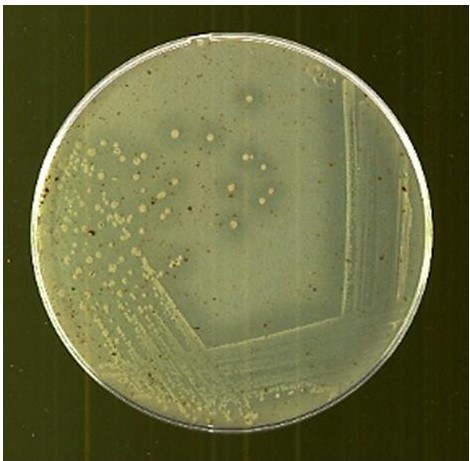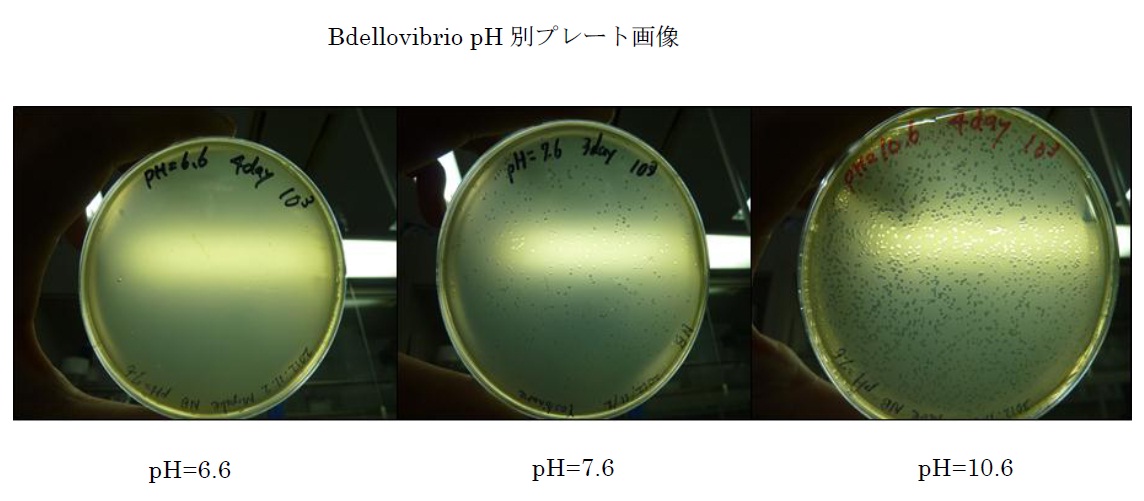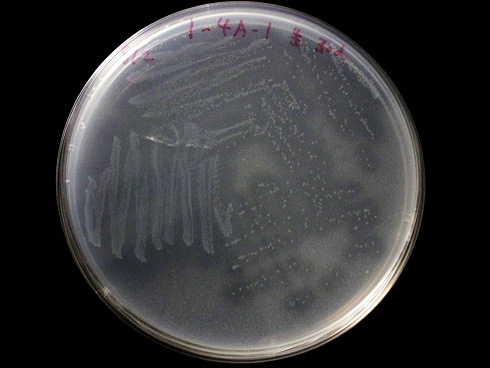Research Contents

Function to reduce waste sludge
・Research Background
Now, most of the waste sludges generated from sewage treatment facilities are landfilled; however, this treat method is a limited and inappropriate way for a norrow country such as Japan. So, developing a new technology for reducing excess sludge is a urgent problem. Also, the technology should be an environmentally-frendly and low-cost method.
・Research Purpose
We have focused sludge-lysing bacteria to construct such a new technology since the use of bacteria for it holds great promise as a low-cost technique for reducing excess sludge based on the idea of bioremediation such as degradation of environmental pollution. Therefore, we are now working to construct a new environmentally-friendly technology for reducing excess sludge by using sludge-lysing bacteria isolated from excess sludge.


<Optimaization of Sludge Reduction by the Bacteria>
We are determining which condition is the best way for efficiently reducing excess sludge by sludge-lysing bacteria.
<Fields> Chemical Engineering, Bioengineering, Environmental Engineering, Chemical Biology, Applied Microbiology
<Identification and Purification of Slude-Lysing Factor>
We are determining what the factor is related to the reduction of excess slduge by various chromatographic techniques and enzyme assays.
<Fields> Enzymology, Bioengineering, Chemical Biology
<Elucidation of the Mechanism for Reducing Excess Sludge>
We are elucidating the mechanism of reducing excess sludge by sludge-lysing bacteria.
<Fields> Applied Microbiology, Bioengineering, Enzymology, Chemical Biology, Environmental Chemistry
<Isolation of Thermophilic Sludge-Lysing Bacteria and Its Utilization>
We are isolating the thermophilic bacteria which can reduce excess sludge at more than 50 degrees C to utilize the bacterial function for reducing excess sludge.
<Fields> Microbiology, Applied Microbiology, Bioengineering, Chemical Biology, Environental Engineering
<Reduction and Utilization of Excess Sludge by Recirculating Flow System of Sludge-Reducing Process>
We are constructing the recirculating flow system for reducing excess sludge with ecofitting and low-cost.
<Fields> Chemical Engineering, Process Engineering, Bioengineering, Chemical Biology, Environmental Engineering
<High-Speed Sludge Reduction by the Combination of Chemical and Biochemical Treatment>
We are constructing a new sludge-reducing way by the combination of chemical and biochemical treatment to enhance the reduction of excess sludge.
<Fields> Chemical Engineering, Process Engineering, Bioengineering, Environmental Engineering
Function of Bdellovibrio strains
・Research Background
Bdellovibrio is a Gram-negative bacterium that preys on other Gram-negative bacteria and grows; therefore, it considered as a "living antibacterial agent." Bdellovibrio has the characteristic of parasitically invading host cells and lyse host bacteria. It has the potential to become a new bacterial treatment technology that destroys and kills host strains. This ability is different with conventional bacterial treatment technologies and is useful to the development of multidrug-resistant bacteria.
・Research Purpose
Our laboratory is conducting research to elucidate the mechanisms of bacterial invasion, parasitism, and bacteriolysis of Bdellovibrio, which are still not fully understood. In addition, to develop useful technologies using Bdellovibrio, we are examining its effectiveness in reducing the volume of excess sewage sludge and in sterilizing oral bacteria.

<Mechanisms of invasion, parasitism, and lysis of Bdellovibrio into Escherichia coli.>
We aim to elucidate the mechanism by pursuing the peformance of invasion, parasitism, and lysis of Bdellovibrio against mutant strains of E. coli.
<Fields> Applied microbiology, biotechnology, genetic engineering, biochemistry
<Development of useful biotechnologies using Bdellovibrio>
We aim to develop technologies to reduce the volume of sewage sludge and inhibit periodontal pathogens by utilizing the interesting functions of Bdellovibrio.
<Fields> Applied Microbiology, Biotechnology, Environmental Engineering

Function to inactivate pathogens
・Research Background
Periodontal diseases are one of the lifestyle-related diseases and 80% of adults are affected to this diasese. It has been reported that more than 300 species of oral bacteria are present in oral cavity and there are cetain regulation systems of cell-to-cell communication such as inhibition, repression, dependence, and enhancement.
・Research Purpose
We are working this project by the collaboration with Prof. Nishihara and Prof. Okinagaga, Kyushu Dental College. The goals of this project are to find a useful strain able to inactivate periodontal pathogens and to analyze the characteristics of the pathogen-deactivating ability.

<Screening of a useful strain able to inactivate periodontal pathogens and characterization of the isolated strains>
We are working to find a useful strain able to inactivate periodontal pathogens and to characterize the ability of the isolated strains.
<Fields>Applied Microbiology, Biotechnology, Dental Engineering, Genetic Engineering, Biochemistry

Function to degrade toxic pollutants
・Research Background
A highly energic chemical, 2,4,6-trinitrotoluene (TNT) has been used as a material of landmine and also has strong genotoxicity and cytotoxicity. Since there have been many TNT-contaminated soil in the United State, Germany and so on, devopling the technology for degrading TNT efficiently will be required.
・Research Purpose
We are now working on three research topics as follows.
1. In the past, we have isolated a TNT-biodegrading strain designated as Pseudomonas sp. TM15. By using the TNT biodegradation ability and the TNT-responsibility of this bacteria, we are making a bioremediation technology for TNT pollution and a biosensor for detecting landmines.
2. It is an interesting research topic how genotoxicy or cytotoxicity will be induced; therefore, we are working to elucidate the mechanism what the reaction happens in the cell.
3. The waste water which has been generated from TNT manufacture is hazardous and dangerous because the water water has indicated strong toxicity, along with a high concentration of carbon and nitrogen source; hence, we are constructing a new technique to safety and completely treat the waste water.


<Identification and Analysis of TNT-Biodegradation Genes Derived from Pseudomoans sp. TM15>
We are working on the identification of TNT-biodegradation genes; in particular, now focusing the pathway of nitro-group and amino-group removal from aromatic ring and the degradation pathway of aromatic ring.
<Fields> Genetic Engineering, Bioengineering, Chemical Biology, Applied Microbiology
<Analysis of the DNA Region with a TNT-Responsive Promoter and Application of the Responsibility>
We have gotten the TNT-responsive regions from Pseudomonas sp. TM15; we are now working to elucidate the mechanism of TNT response.
<Fields> Genetic Engineering, Genetics, Chemical Biology, Bioengineering
<Chemical and Biochemical Treatment of the Waste Water Generated from TNT Manufacture>
We are constructing a new method to treat the waste water safety and cheaply.
<Fields> Chemistry, Chemical Engineering, Applied Microbiology, Bioengineering, Chemical Biology, Environmental Chemistry
<Elucidation of the Mechanism of Toxicity Induced by TNT Explosive>
We are working to elucidate the mechanism how toxicity has been induced by TNT.
<Fields> Genetics, Genetic Engineering, Chemical Biology, Environmental Chemistry
<Degradation of TNT-polluted soil by Pseudomonas sp. TM15>
We are working to test the degradation of TNT-polluted soil by Pseudomonas sp. TM15 to construct a bioremedation for TNT.
<Fields> Environmental Chemistry, Environmental Engineering, Bioengineering, Applied Microbiology